
Mini-Lesson for What Is Democracy?
Mini-Lesson for What Is Democracy?
Mini-Lesson for What Is Democracy?
Themes: Democracy
Ages: 15-17
What is Democracy?, Astra Taylor, provided by the National Film Board of Canada
Keywords/Topics: Democracy, Tyranny of the Majority, Civil Rights, Direct Democracy, Representative Democracy, Universal Suffrage, Minority Rights
Guiding Question: Is democracy truly the best system for all? Do our modern democratic institutions favour some people over others? Are modern democracies controlled by the rich?
Summary: Astra Taylor’s film What Is Democracy? explores different interpretations of democracy, both historical and modern. By interviewing a range of characters, including former prisoners, civil rights activists, Greek scholars and current politicians, Taylor explores to what extent modern democracy truly represents all citizens. Note: There is some swearing in a few of the segments.
Activity #1
This is a pre-screening activity in order to engage students.
In each corner of the classroom, put up a bright piece of paper that says one of the following: Strongly Agree, Agree, Disagree or Strongly Disagree.
Students will be presented with controversial statements one by one. They are to read the statement and then move to the corner that best represents their position on the statement.
Potential Statements:
- Democracy is the best political system.
- Prisoners should have the right to vote.
- Modern democracy is controlled by the rich.
- Justice is more important than freedom.
Rules:
The teacher will lead the students in discussing their choices. Students must be prepared to justify why they have chosen a particular corner. If students find another person’s reasoning convincing enough, they can change positions during the discussion.
Go Deeper
Following the discussion, students should watch the above clip. Minister William Barber II speaks at a rally about how democracy has been curtailed through voter suppression in the United States. This leads into the testimony of a young girl questioning how her struggle for rights differs from that of protestors in the earlier American civil rights movements. Both segments deal with who controls democracy and whether it is truly the best system. What changes would the students propose to improve democracy?
Activity #2
Have students brainstorm a list of conditions required for a country to be considered a democracy. Examples could include: fair elections, full suffrage, free speech, civil rights, freedom of the press, strong public education. Once the list is generated, have students rank the conditions in order of most to least important.
Then have students watch the above clip. Discuss how poverty has an impact on democracy. Why do the doctors in the film clip want more money spent on education?
Go Deeper
Students could explore this question in more depth by examining different ranking systems of how democratic or “free” a country is.
Activity #3
This clip discusses what barriers remain to ensure that a full “voice of the people” is heard. A former prisoner, now a hair stylist, eloquently discusses what democracy means to him. He questions why he is denied the right to vote when corporate crime seems to get swept under the proverbial rug. Using his questions as a base, challenge students to propose and defend their top three changes to protect democracy for all people. What changes would they make to Canadian (or any) society in order to improve democracy? Suggestions could range from changing the judicial system, revamping the electoral system and reforming education to single terms for executives, proposed checks and balances, etc. Encourage students to be creative in their choices. Should they so wish, they could also propose their top three reasons why democracy is the worst of the options for political organization.
Go Deeper
In a higher-level class, students could be encouraged to research a philosopher whose ideas underpin their own. They could then find a supporting quotation from a primary source that supports their ideas.
For a comparative-politics approach, students could be encouraged to compare political systems and debate which ones are more “democratic” – American vs. Canadian, Swiss vs. Italian, etc. – and why.
Carla McIvor currently teaches Social Studies at West Island College in Calgary, Alberta. She has also taught courses ranging from Philosophy to Comparative Government in British Columbia and Ontario. Carla has a B.A. in Political Science from McGill University, a B.Ed. from University of Ottawa and a master’s degree in International Relations from the University of Geneva.
Pour lire cet article en français, cliquez ici.
Discover more Mini-Lessons | Watch educational films on NFB Education | Watch educational playlists on NFB Education | Follow NFB Education on Facebook | Follow NFB Education on Pinterest | Subscribe to the NFB Education Newsletter



